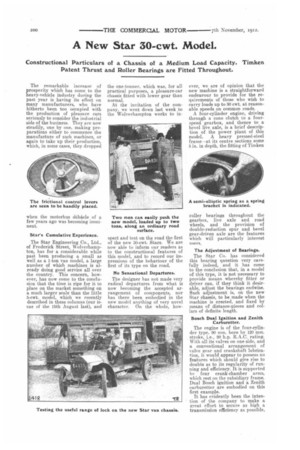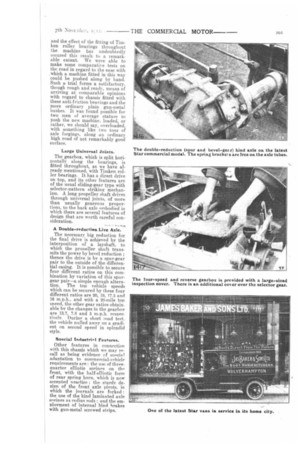A New Star 50-cwt. Model.
Page 4

Page 5

If you've noticed an error in this article please click here to report it so we can fix it.
The remarkable increase of prosperity which has come to the heavy-vehicle industry during the past year is having its effect on many manufacturers, who have hitherto been too occupied with the production of pleasure cars seriously to consider the industrial side of the business. They are now steadily, one by one, making preparations either to commence the manufacture of such machines, or again to take up their production, which, in some cases, they dropped
when the motorbus debacle of a few years ago was becoming imminent.
Star's Cumulative Experience.
The Star Engineering Co., Ltd., of Frederick Street, W olverhampton, has for a considerable while past been producing a small as well as a 1-ton van model, a large number of which machines is already doing good service all over the country. This concern, however, has now come to the conclusion that the time is ripe for it to place on the market something on a much larger scale than the little 5-cwt. model, which we recently described in these columns (our issue of the 15th August last), and
the one-tonner, which was, for all practical purposes, a pleasure-car chassis fitted with lower gear than normal.
At the invitation of the company, we went down last week to the Wolverhampton works to in spect and test on the road the first of the new 30-cwt. Stars, We are now able to inform our readers as to the constructional features of this model, and to record our impressions of the behaviour of the first of its type on the road.
No Sensational Departures.
The designer has not made very radical departures from what is now becoming the accepted arrangement of components, nor has there been embodied in the new model anything of very novel character. On the whole, how ever, we are of opinion that the new machine is a straightforward endeavour to provide for the requirements of those who wish to carry loads up to 30 cwt. at reasonable speeds on common roads. A four-cylinder engine, driving through a cone clutch to a fourspeed gearbox, and thence to a bevel live axle, is a brief description of the power plant of this model. A heavy pressed-steel frame—at its centre sections some 5 in. in depth. the fitting of Timken
roller bearings throughout the gearbox, live axle and road wheels, and the provision of double-reduction spur and bevel gear-driven axle are the features which will particularly interest users.
The Adjustment of Bearings.
The Star Co. has considered this bearing question very carefully indeed, and it has come to the conclusion that, in a model of this type, it is not necessary to provide means whereby fitter or driver can, if they think it desirable, adjust the bearings endwise. Such adjustment is, on the new Star chassis, to be made when the machine is erected, and fixed by means of distance-pieces and collars of definite length.
Bosch Dual Ignition and Zenith Carburetter.
The engine is of the four-cylinder type, 90 Trim, bore by 120 num. stroke, i.e., 20 h.p. R.A.C. rating. With all its valves on one side, and a conventional arrangement of valve .gear and crankshaft lubrication, it would appear to possess no features which should give rise to doubts as to its regularity of running and efficiency. It is supported by four crank-chamber arms, which rest on the subsidiary frame. Dual Bosch ignition and a Zenith carburetter are embodied on this first example.
It has evidently been the intention of the company to make a great effort to secure as high a transmission efficiency as possible, and the effect of the fitting of Timken roller bearings throughout the machine has undoubtedly secured this result to a remarkable extent. We were able to make some comparative tests on the road in regard to the ease with which a machine fitted in this way could be pushed along by hand. Such a trial forms a satisfactory, though rough and ready, means of arriving at comparable opinions with regard to chassis fitted with these anti-friction bearings and the more ordinary plain gun-metal bushes. It was found possible for two men of average stature to push the new machine, loaded, or rather, we should say, overloaded, with something like two tons of axle forgings, along an ordinary high road of not remarkably good surface.
Large Universal Joints.
The gearbox, which is split horizontally along the bearings, is fitted throughout, as we have a!ready mentioned, with Timken roller bearings. It has a direct drive on top, and its other features are of the usual sliding-gear type with selector-pattern striking mechanism. A long propeller shaft drives through universal joints, of more than usually generous proportions. to the back axle embodied in which there are several features of design that are worth careful consideration.
A Double-reduction Live Axle.
The necessary big reduction for the final drive is achieved by the interposition of a layshaft, to which the propeller shaft transmits the power by bevel reduction ; thence the drive is by a spur-gear pair to the outside of the differential casing. It is possible to secure four different ratios on this cora bination by variation of this spurgear pair—a simple enough alteration. The top vehicle speeds which can be secured by these four different ratios are 20, 19, 17.5 and 16 m.p.h., and with a 20-mile top speed, the other gear ratios obtainable by the changes in the gearbox are 13.7. 7.8 and 5 m.p.h. respectively. Durinrr a short road test. the vehicle pulled away on a gradient on second speed in splendid style.
Special indastri/4 Features.
Other features in connection with this chassis which we may recall as being evidence of special adaptation to commercial-vehicle requirements are : the use of threequarter elliptic sprinrei on the front, with the half-ellintic form of rear spring horn, which is now accepted nractice ; the sturdy design of the front axle pivots, in which the journals are forked ; the use of the hind laminated axle snrinrrs as radius rods: and the employment of internal hind brakes with 'gun-metal screwed strips.


























